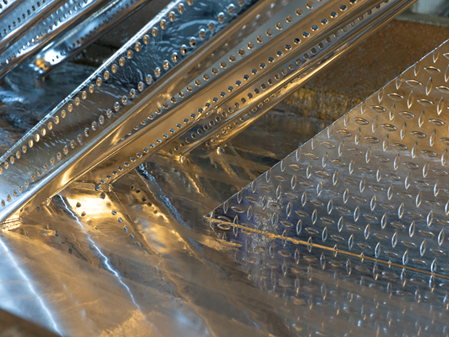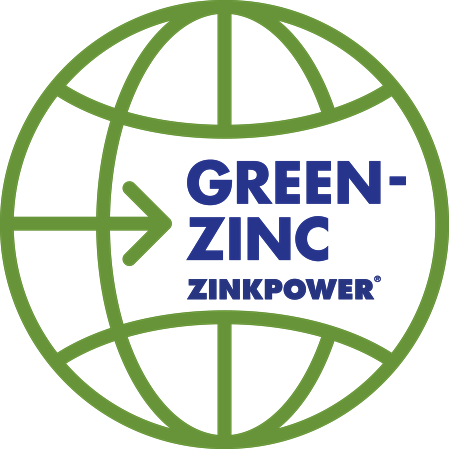SUPPORTING A SUSTAINABLE FUTURE: ON THE WAY TO NET ZERO
Environment: Setting new standards
ZINKPOWER contributes to greater ecological sustainability in many ways: Our hot-dip galvanizing service ensures robust, durable and maintenance-free steel products which remain fit for operation and use for many years or even decades.
Our aspiration goes beyond the usual - this is how we set new standards.
Durable, recyclable and on the way to net zero carbon emissions: Hot-dip galvanizing enables ZINKPOWER to actively contribute to the industry's ecological sustainability.
Materials
Thanks to its optimum corrosion protection, the service life of steel structures can be extended to more than 50 years - and usually without the need for maintenance. This sustainable approach makes it possible to create durable and robust structures that will continue to meet the requirements of environmental protection and resource efficiency in the future. This sustainable approach means that durable and robust buildings can be created that will continue to fulfil the requirements of environmental protection and resource efficiency in the future.
-
Circular economy at ZINKPOWER
ZINKPOWER relies on a comprehensive circular economy to minimise waste and to ensure the efficient use of resources. Every step in the hot-dip galvanizing process is designed to reuse valuable materials and reduce the ecological footprint - from pre-treatment of the steel to zinc recycling. At the heart of this sustainable cycle is our hot-dip galvanizing process.
Processes in detail

- 1 ZINKPOWER Plant
-
Customers deliver steel and metal parts themselves or use our transport and collection services. In some cases our haulage companies also use environmentally-friendly e-trucks to ensure efficient and sustainable transport.
- 2 Pre-treatment
-
Before the steel can be hot-dip galvanized, rust, grease, oil and foreign impurities have to be removed to achieve optimum results. This pre-treatment involves several important steps for ensuring that the steel surface is clean and free of impurities.
- 3 Pre-treatment recycling
- 3.1 Acid treatment plant
In one of our US plants, a recycling facility which uses oxalic acid to recover hydrochloric acid from iron pickles is being run as a pilot project. The resulting filter cake can be safely disposed of, while the recycled hydrochloric acid is returned to the pickle bath.
3.2 Wet scrubber
The wet scrubber cleans the air from the enclosed pre-treatment. The recovered acid is fed back into the pre-treatment process.
3.3 Dust collection system
Dust collection systems in the galvanizing plants capture and clean dust particles from our enclosed zinc kettles. The fine dust obtained is passed on to disposal companies for further processing.
3.4 Flux treatment system
Iron is removed from the flux in flux treatment systems developed in-house. This step reduces the number of transports of hazardous goods and our dependence on suppliers. This also improves the quality of the surface of the galvanized goods.
- 4 Zinc bath
-
Following preparation in the flux bath, steel is dipped into molten zinc at around 450 °C. This forms a resistant zinc-iron layer which protects the steel effectively from corrosion and ensures its longevity.
- 5 Ashes
-
Zinc ash is produced as a by-product of the reaction between molten zinc and the steel surface. This zinc ash is regularly skimmed off the zinc bath and collected. In the recycling plant, we extract our SUZI® zinc from the ash, which we reuse in the galvanizing process.
The fine ash is used by companies to produce zinc oxide, which is then used in pharmaceuticals, tyre production, as a paint pigment and in the semiconductor industry.
- 6 Dross
-
We recycle dross externally. It is then used as a secondary raw material for zinc oxide production.
- 7 Hot-dip galvanized steel
-
Hot-dip galvanized steel is corrosion-resistant and durable – these are ideal requirements for use in a range of demanding environments.
- 8 Basis for further climate protection measures
-
Hot-dip galvanized steel is a key enabler for numerous infrastructure and climate protection projects. This is because it plays a key role in the realisation and sustainability of these projects thanks to its superior corrosion resistance and durability.
Energy and emissions
As part of our “ZINKPOWER Way to Zero” programme, we have set ourselves the strategic goal of continuously cutting our emissions and reducing the associated environmental impact down to zero. This includes minimizing our greenhouse gas emissions, using renewable energy sources and implementing resource-efficient processes.
Scope 1, 2, 3 overview according to the Greenhouse Gas Protocol (GHG Protocol)
Total emissions*
Our carbon footprint includes
Energy consumption - Our total energy consumption includes electricity, natural gas and renewable energies. To promote transparency and efficiency, we analyze our energy consumption by type of energy. Our aim is to produce more energy-efficiently, increase the proportion of renewable energy and reduce the use of fossil fuels.
Emissions - Our emissions comprise the direct and indirect release of greenhouse gases that arise in the course of our business activities. This includes both operational emissions (Scope 1) and emissions resulting from the use of energy (Scope 2) and from upstream and downstream activities in the value chain (Scope 3).
Reduction strategies - To significantly reduce our CO₂ emissions, we are focusing on electric instead of gas-powered plants, the expansion of renewable energies and the increased purchase of low-carbon zinc. In this way, we are systematically driving forward the decarbonization of our processes and supply chain - a key step on the way to a more climate-friendly future.
Sustainable Highlights
Example 1: Low-Carbon Zinc
As a pioneer in the galvanizing industry, we have been using low-carbon zinc for galvanizing since the beginning of 2022. To underline our sustainability focus, we use the name “Green Zinc” for this raw material.
The zinc we use is mined and produced exclusively using renewable energy from hydropower and wind power. By using Green-Zinc, we reduce our CO₂ emissions by three kilograms per kilogram of zinc.*
As a comparison, according to the International Zinc Association, the production of one kilogramme of conventional zinc generates around four kilogrammes of CO₂.
This innovative approach supports our vision of a more environmentally-friendly future and is setting new standards in the industry.
* The figures given are subject to annual changes.
Example 2: Transformation of our plants
As part of our “ZINKPOWER Way to Zero” programme, we are setting new standards in the galvanizing industry with a project in Styria which is generating a great deal of interest. Since the beginning of 2023, Austria's largest galvanizing kettle at ZINKPOWER Sinabelkirchen GmbH has been heated electrically – we previously used gas.
The switch has been made by using carbon-neutral electricity from hydropower. This innovative measure will enable us to reduce our site's CO₂ emissions by an impressive 1,549 tonnes in the 2023/2024 financial year compared to the 2022/2023 financial year. With transformations like these, our aim is to significantly reduce the ecological footprint of our production sites and in doing so make a significant contribution to environmental protection.
Example 3: SUZI®-Zink
We produce zinc by processing zinc ash at our European sites in Brunn (Austria) and Neumünster (Germany) as well as in Indonesia, Mexico, Brazil, the US and the United Arab Emirates.
The process begins with zinc ash being ground in a ball mill. A sieve separates metallic raw zinc and fine ash. We then melt the raw zinc in a furnace at 450 degrees Celsius and separate it from the ash it still contains. At the site in Brunn, we use biogas as a source of energy. We feed the remelted zinc obtained in this way back into the galvanizing process as SUZI-Zinc.
-
-




